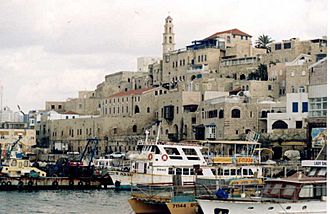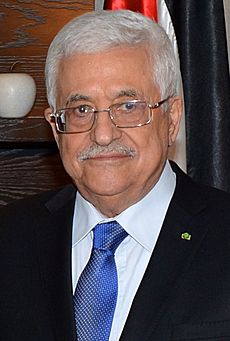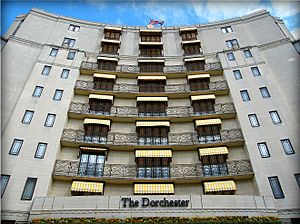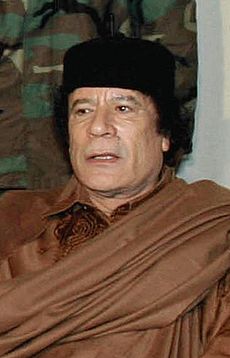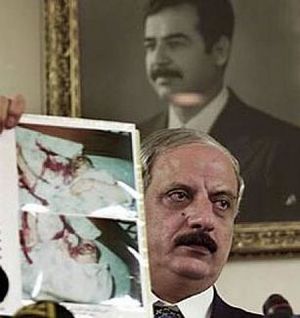Abu Nidal facts for kids
Quick facts for kids
Abu Nidal
أبو نضال |
|
|---|---|
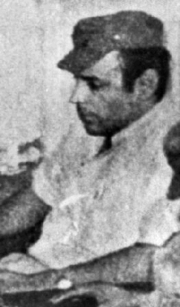
Abu Nidal in an image released in 1976
|
|
| Born |
Sabri Khalil al-Banna
صبري خليل البنا May 1937 Jaffa, Mandatory Palestine
|
| Died | 16 August 2002 (aged 65) |
| Resting place | al-Karakh Islamic cemetery, Baghdad |
| Nationality | Palestinian |
| Organization |
Fatah: The Revolutionary Council
(فتح المجلس الثوري) known as the Abu Nidal Organization |
| Movement | Palestinian Rejectionist Front |
Sabri Khalil al-Banna (born May 1937 – died 16 August 2002) was a Palestinian leader. He was known by his nickname Abu Nidal, which means "father of struggle." He started a group called Fatah: The Revolutionary Council. This group is more commonly known as the Abu Nidal Organization (ANO). In the 1970s and 1980s, the ANO was seen as one of the most active Palestinian groups.
Abu Nidal formed the ANO in October 1974. This happened after he separated from Yasser Arafat's Fatah group. The Fatah group was part of the Palestine Liberation Organization (PLO). Abu Nidal's group is believed to have carried out attacks in 20 countries. These actions caused many deaths and injuries. One example is the Rome and Vienna airport attacks on 27 December 1985. Gunmen opened fire on passengers at airport ticket counters.
Abu Nidal died in his Baghdad apartment in August 2002. Some Palestinian sources believe he was killed.
Contents
Early Life
Family and Childhood
Sabri Khalil al-Banna was born in May 1937 in Jaffa. This city was on the Mediterranean coast of what was then British Mandate of Palestine. His father, Hajj Khalil al-Banna, owned large orange groves. The family lived in a big stone house near the beach.
Sabri's father had several wives. Sabri was the 12th of his father's children. In 1944 or 1945, his father sent him to a French mission school. He attended for one year. When his father died in 1945, Sabri was seven years old. His family then enrolled him in a private Muslim school in Jerusalem. He attended this school for about two years.
The 1948 War
On 29 November 1947, the United Nations decided to divide Palestine. They planned to create an Arab state and a Jewish state. Fighting started right away. This conflict affected his family's income.
Just before Israeli troops took Jaffa in April 1948, his family left their home. They went to their house near Majdal. But Israeli troops arrived there too. The family had to leave again. This time they went to the Bureij refugee camp in the Gaza Strip. The family spent nine months living in tents. They relied on aid for food. This experience had a strong effect on Abu Nidal.
Moving to Nablus and Saudi Arabia
The al-Banna family had business experience. They also managed to save some money. This helped them start a new business. Their orange groves were now part of the new state of Israel. The family moved to Nablus in the West Bank.
In 1955, Abu Nidal finished high school. He joined the Arab nationalist Ba'ath party. He started studying engineering at Cairo University. But he left after two years without finishing his degree. In 1960, he went to Saudi Arabia. There, he worked as a painter and electrician. He also worked as a laborer for Aramco. In 1962, he met his wife during a visit to Nablus. They had a son and two daughters.
Personality and Leadership
Abu Nidal was often not in good health. He was known for being very secretive. He did not trust many people. He lived hidden from public view. People who knew him said he worked hard. They also said he was good with money.
Some people believed his childhood experiences shaped his personality. The loss of his home and status in the conflict with Israel affected him. This might have led to his strict leadership style within the ANO. He was very controlling of his group members.
Political Life
Early Activism
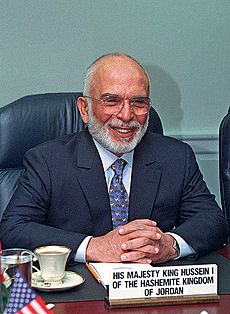
In Saudi Arabia, Abu Nidal helped start a small group of young Palestinians. Their activism led to him losing his job. The Saudi government also imprisoned and then expelled him. He returned to Nablus with his family. He then joined Yasser Arafat's Fatah group.
He was committed to Palestinian politics. But he was not very active until Israel won the 1967 Six-Day War. This war led to Israel taking control of new territories. This event motivated him to become more active.
After moving to Amman, Jordan, he started a trading company called Impex. This company was a front for Fatah. It served as a meeting place and helped move money. This became a common practice for Abu Nidal. Companies controlled by the ANO made him wealthy. They did legal business deals. But they also helped hide arms deals and other activities.
When Fatah asked him to choose a nickname, he chose Abu Nidal. This name means "father of struggle." He chose it after his son, Nidal. In 1970, he became the Fatah representative in Baghdad. This was two months before "Black September." During Black September, King Hussein's army forced Palestinian fighters out of Jordan.
First Major Operation
After Black September, Abu Nidal criticized the PLO. He said they were weak for agreeing to a ceasefire. In 1971, he called for more democracy within Fatah. He also called for revenge against King Hussein.
In February 1973, a Palestinian activist named Abu Daoud was arrested in Jordan. He was arrested for trying to harm King Hussein. This led to Abu Nidal's first operation. It was called Al-Iqab ("the Punishment"). On 5 September 1973, five gunmen entered the Saudi embassy in Paris. They took 15 hostages. They threatened to blow up the building if Abu Daoud was not released. The gunmen later flew to Kuwait and then to Riyadh. They surrendered and released the hostages on 8 September. Abu Daoud was released from prison two weeks later.
Abu Nidal carried out this operation without Fatah's permission. PLO leaders, including Abu Iyad and Mahmoud Abbas, were upset. They believed hostage-taking harmed the movement. From then on, the PLO saw Abu Nidal as being controlled by the Iraqi government.
Leaving Fatah
Two months later, in November 1973, the ANO hijacked a plane. This time they used the name Arab Nationalist Youth Organization. The hijacking was meant to warn Fatah not to attend a peace conference. In response, in 1974, Yasser Arafat removed Abu Nidal from Fatah.
In October 1974, Abu Nidal formed the ANO. He called it Fatah: The Revolutionary Council. A Fatah court later sentenced him to death in his absence. This was for trying to harm Mahmoud Abbas. However, it is thought that Fatah did not truly want to kill Abu Nidal. He was allowed to leave Beirut after discussing the sentence. But it was clear he was no longer welcome. As a result, the Iraqis gave him Fatah's resources in Iraq. This included a training camp, a newspaper, and weapons. He also received regular aid from Iraq.
The ANO (Abu Nidal Organization)
How the Group Worked
The ANO used many different names. These included Black June, Black September, and the Revolutionary Arab Brigades. The group had up to 500 members. They were chosen from young men in Palestinian refugee camps and Lebanon. They were promised good pay and help for their families.
Members were sent to training camps. These camps were in countries that supported the ANO, like Syria, Iraq, or Libya. After joining, members were not allowed to leave. The group had complete control over its members. Recruits had to write their life stories. They also had to sign a paper agreeing to be executed if they were found to be spies. The ANO's newspaper often announced the execution of "traitors."
Special Operations
The ANO had different parts to its organization. One part was the Intelligence Directorate. It was formed in 1985 to manage special operations. It had subcommittees. These included the Committee for Special Missions and the Foreign Intelligence Committee. This directorate managed the ANO's hidden weapons in different countries. It also trained staff and arranged travel documents.
The Committee for Special Missions chose targets. This committee was led by Dr. Ghassan al-Ali. He was known for favoring "the most extreme and reckless operations."
Operations and Relationships
Shlomo Argov Attack
On 3 June 1982, an ANO member shot Shlomo Argov. He was the Israeli ambassador to Britain. The shooting happened as he left the Dorchester Hotel in London. Argov survived but was disabled for the rest of his life. The PLO quickly said they were not responsible for the attack.
Ariel Sharon, Israel's defense minister at the time, responded three days later. He invaded Lebanon, where the PLO was based. Some believe Abu Nidal intended this. He may have wanted to give Israel a reason to attack the PLO.
Rome and Vienna Airport Attacks
Abu Nidal's most well-known operation was the 1985 attack on the Rome and Vienna airports. On 27 December, four gunmen opened fire at the Leonardo Da Vinci International Airport in Rome. They killed 16 people and wounded 99. A few minutes later, at Vienna International Airport, three men threw hand grenades. They killed four people and wounded 39.
These attacks caused great harm to the PLO's image. Many people in the West could not tell the difference between the ANO and Fatah. This led ordinary people to think that all Palestinians were involved in such actions.
US Bombing of Libya
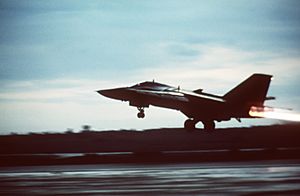
On 15 April 1986, the US launched bombing raids against Tripoli and Benghazi. This was in response to a bombing of a nightclub in Berlin. The nightclub was used by US service members. After the airstrikes, some kidnapped people were killed. These included British journalist Alec Collett. The bodies of two British teachers and an American were also found. A group linked to Abu Nidal claimed responsibility.
Hindawi Affair
On 17 April 1986, a pregnant Irish woman named Ann Marie Murphy was found at Heathrow airport. She had a bomb hidden in her bag. She was about to board a flight to Tel Aviv. Her Jordanian fiancé, Nizar Hindawi, had packed the bag. It is believed that Abu Nidal's group made the bomb. It was sent to London in a diplomatic bag. This attack was possibly a response to Israel forcing down a jet carrying Syrian officials.
Pan Am Flight 73 Hijacking
On 5 September 1986, four ANO gunmen hijacked Pan Am Flight 73. This happened at Karachi Airport. They held 389 passengers and crew for 16 hours. Then they set off grenades inside the plane. Neerja Bhanot, a flight attendant, opened an emergency door. Most passengers escaped. But 20 people died, including Bhanot, and 120 were wounded.
Relationship with Muammar Gaddafi
Abu Nidal moved his organization to Libya in 1986. He arrived there in March 1987. In June of that year, the Syrian government expelled him. This was partly because of the Hindawi affair and the Pan Am Flight 73 hijacking.
Abu Nidal and Libya's leader, Muammar Gaddafi, reportedly became close. This relationship gave Abu Nidal a supporter. It also gave Gaddafi a group to use for his own purposes. In Libya, Abu Nidal became even more controlling. He did not allow his members to socialize with each other. All meetings had to be reported to him. Members were not allowed to travel without his permission.
Abu Nidal reportedly claimed to be involved in the bombing of Pan Am Flight 103. This plane exploded over Lockerbie, Scotland, on 21 December 1988. However, it is believed the ANO had no real connection to it. Abu Nidal often claimed responsibility for events he was not involved in.
Banking with BCCI
In the late 1980s, British intelligence learned that the ANO had bank accounts. These accounts were with the Bank of Credit and Commerce International (BCCI) in London. BCCI was closed in 1991 due to widespread fraud. Abu Nidal reportedly visited London using a fake name. He used a company in Warsaw to hide arms deals.
Assassination of Abu Iyad
On 14 January 1991, in Tunis, the ANO killed Abu Iyad. He was the head of PLO intelligence. Two other Fatah aides were also killed. The killer confessed that an ANO member had hired him. Abu Nidal had a strong dislike for Abu Iyad. This was partly because Abu Iyad had kept Abu Nidal out of the PLO. This murder was seen as Abu Nidal settling old disagreements.
Death
After Libyan agents were charged with the Lockerbie bombing, Gaddafi tried to distance himself from terrorism. Abu Nidal was expelled from Libya in 1999. In 2002, he returned to Iraq. The Iraqi government later said he entered the country using a fake passport.
On 19 August 2002, a Palestinian newspaper reported that Abu Nidal had died. He died three days earlier from multiple gunshot wounds. This happened at his home in Baghdad. The newspaper said the house was owned by the Iraqi secret service. Two days later, Iraq's chief of intelligence showed reporters photographs of Abu Nidal's body.
Some reports suggest that Iraqi intelligence found secret documents in his home. These documents were about a possible US attack on Iraq. When they raided the house, fighting broke out. In the middle of this, Abu Nidal was killed. It is thought that Saddam Hussein might have had him killed. This was because he feared Abu Nidal would act against him if the Americans invaded.
Another report from September 2002 said that Iraqis were questioning Abu Nidal. They suspected he was a spy for Kuwait and Egypt. Just before he was moved to a more secure place, Abu Nidal asked to change his clothes. He went into his bedroom and died. He was buried on 29 August 2002 in Baghdad.
See Also
 In Spanish: Abu Nidal para niños
In Spanish: Abu Nidal para niños
- List of unsolved deaths


